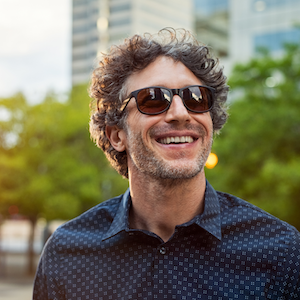Protecting Your Eyes from UV Rays
 You’re standing outside. You breathe in the fresh air and feel the sunlight hitting your skin. Before stepping outside, you may have applied sunscreen or dressed in protective clothing to combat the ultraviolet (UV) rays. But what about your eyes?
You’re standing outside. You breathe in the fresh air and feel the sunlight hitting your skin. Before stepping outside, you may have applied sunscreen or dressed in protective clothing to combat the ultraviolet (UV) rays. But what about your eyes?
UV rays, UV light, UV wavelength, and UV index are all words we may have heard before. We heard countless times of the damaging effects UV light can have on the skin. But we rarely hear of the damage it can take to your eyes and vision.
A quick science lesson — UV light can come from artificial sources such as tanning beds, sunlamps, welding torches, and sanitizing bulbs, but the natural source of UV light is the sun. The sun radiates electromagnetic waves. These waves are classified by wavelength and divided into three categories: UVC, UVB, and UVA. All invisible to the naked eye.
While UVC rays never reach the Earth, only 5% of UVB rays breach the ozone layer. Although a small percentage, UVB rays are the cause of sunburns. UVB rays have a short wavelength with high frequency and energy, allowing them to penetrate the skin and cause a sunburn after long exposure. 95% of UVA rays stretch from the sun to the Earth. UVA rays have a longer wavelength than UVB with lower energy that can permeate deep into the skin. Through summer, winter, and even clouds, UV rays will always surround us. But how does it affect our eyes?
Just like our skin, these UV rays can produce both short-term and long-term symptoms in our eyes. Short-term, exposure to UV rays can cause a condition called Photokeratitis — in layman’s terms, it can cause a sunburn on your cornea. Long-term, prolonged UV exposure can result in eye diseases such as cataracts, macular degeneration, and eye-related cancer.
So, how do we know when it’s safe or unsafe for our eyes? The UV index is the intensity of UV light according to the season, day, time, region, and elevation. Weather channels measure the intensity on a scale of 1 to 11. Levels 1 and 2 are typically safe and do not require any added protection. Levels ranging from 3 to 7 can be damaging. Precautionary measures should be taken at this intensity. At levels 8 to 11, added protection must be worn.
When looking for UV protection, sunglasses are our strongest soldier against UV rays, but not all sunglasses are created the same. Choosing the best kind of sunglasses is key. Opt for sunglasses that block 100% of UVA and UVB rays. If regularly outside for long periods of time, choose a wraparound option. These will protect the contours of your face from the sun peeking in around the edges. Bonus – add a double layer of protection by wearing a hat with your sunglasses.
Keep you and your family protected from damaging UV rays and stop by to try on a stylish pair of sunglasses. Visit us at our Tri-County or Kehoe locations today!
